f you don’t want your staff and patients to struggle with paper bills, keep reading to learn more about medical billing software development and how this type of software works. Luvina – one of the leading experts in software technology, will guide you through the complexities of medical billing software development to significantly reduce billing errors and ensure smooth financial transactions while improving the efficiency of healthcare management.
What is Medical billing software?
Medical billing software is a digital tool that automates financial management and billing processes. This software can reduce human errors and integrate with electronic health records to capture all billable services throughout a patient’s journey.
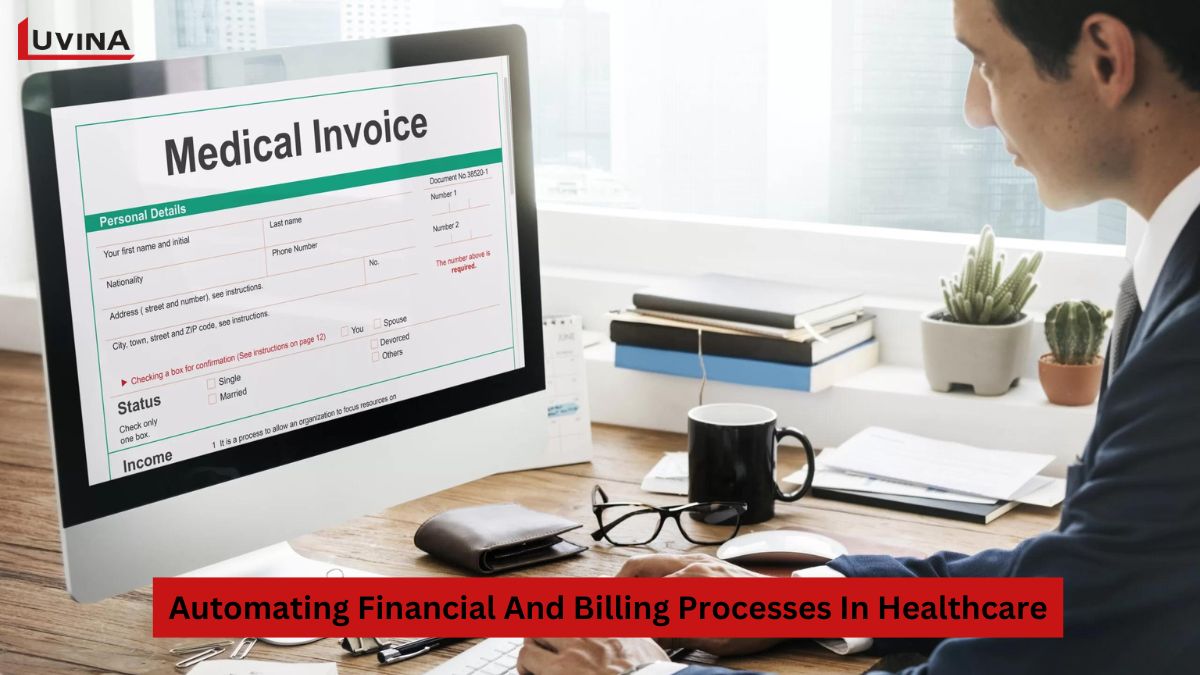
Large and small hospitals can benefit from medical billing software development today. Small clinics can start with basic software options, while larger organizations will use more comprehensive platforms.
Features of Medical billing software
If you’re considering medical billing software development, here are some basic features we believe should be included in your Minimum Viable Product (MVP):
| No. | Features | Description |
| 1 | Automated Billing Process | From patient registration to invoice reminders and payment tracking, the software will transfer information between departments without manual intervention. You only need to set up billing rules once, and the app will apply them automatically. |
| 2 | Electronic Health Record Integration | Helps manage patient care, improves workflow efficiency, reduces data fragmentation, and enhances collaboration. |
| 3 | User-Friendly Interface | Increases ease of use, allowing users to quickly adapt to the software. |
| 4 | Reporting and Analytics | Enables healthcare staff to create visual reports, provides administrators with insights into performance, and helps develop data-driven strategies. |
| 5 | Credit Card Processing | Provides a seamless experience and enhances flexibility in payment options. |
| 6 | Data Storage and Retrieval | Allows quick access to patient information. |
| 7 | Cloud Access | Lets users access the software from anywhere with an internet connection. |
| 8 | Patient Portal | Improves engagement and satisfaction by letting patients access payment information, view payment reports, and pay online. |
Understanding medical billing software work
Before going in-depth regarding how medical billing software works, let’s have a look at the traditional process of billing and payment at a healthcare facility without modern software:
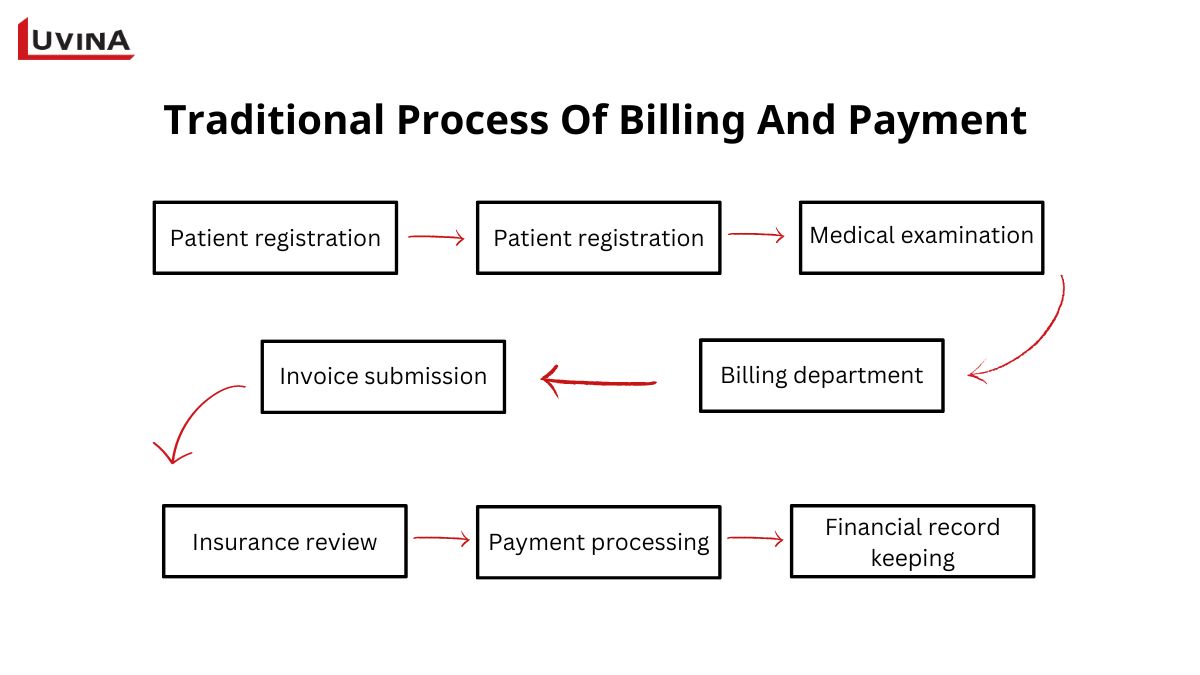
- Patient registration: A patient checks in at the reception desk.
- Insurance verification: Healthcare staff examines whether the patient has valid insurance.
- Medical examination: The doctor performs the necessary examinations, records diagnoses, and details treatments given.
- Billing department: This is where the procedures performed are identified, along with assigning medical codes and generating the bill.
- Invoice submission: The bill is forwarded to the insurance company for all medical services with code or a claim is filed for reimbursement.
- Insurance review: The bill submitted is reviewed by the insurance company, which may be accepted, adjusted, or rejected. It may require adjustment, in which case the billing department has to re-forward the claim to the insurance providers on the said grounds.
- Payment processing: A record of the payment received is recorded by the billing department after the claim is approved. It then makes the necessary collections from the patient.
- Financial record keeping: Financial records are updated to reflect outstanding payments and approved claims.
Overall, without automated healthcare software, staff must manually coordinate each step to collect payments for services rendered. This is a time-consuming process requiring high attention to detail. However, with medical billing software development, this process becomes streamlined and differs as follows:
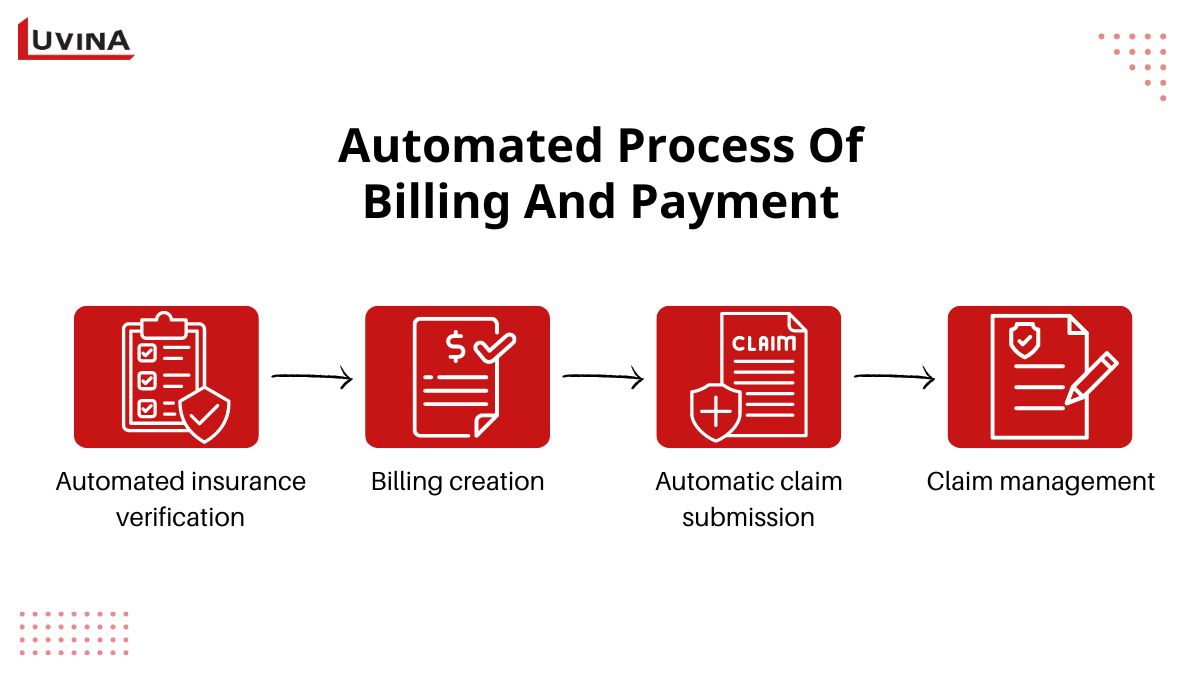
- Automated insurance verification: The system automatically checks insurance eligibility in seconds with fewer errors, reducing patient wait times and saving doctors’ time.
- Billing creation: The billing software integrates with EHR/EMR systems, accessing all procedures and treatments provided to the patient to generate a comprehensive invoice. The invoice can be shared with the patient for verification of accuracy and cost details.
- Automatic claim submission: Claims are automatically sent to insurance companies.
- Claim management: The software stores information about whether the insurance company or the patient paid the bill, and sends reminders to patients if invoices remain unpaid, or if insurance coverage is about to expire.
As you can see, every process is executed clearly and quickly. Medical billing software development helps automate the entire billing process, freeing doctors and healthcare staff from redundant tasks, reducing financial errors, and ensuring regulatory compliance.
Benefits of implementing medical billing software
Medical billing software development automates processes for healthcare providers, hence reducing administrative burdens and providing the following benefits:
- Smoother payment processes: Automates data entry, reduces errors, speeds up claim processing, and shortens the time between service delivery and payment. This smooths cash flow and ensures financial stability for all healthcare activities.
- Keeping up with technological advancement: Ensures competitiveness and compliance by providing access to the latest coding standards and security measures.
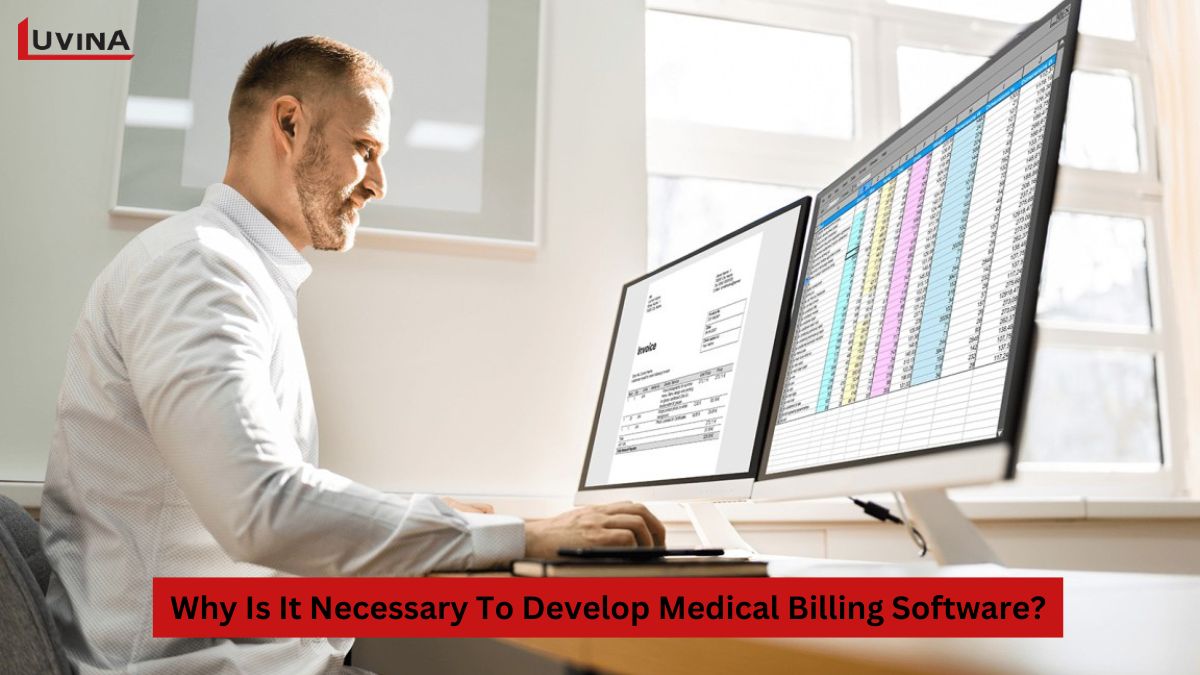
- Overcoming common manual billing challenges: Identifies errors before claims are submitted, reduces claim denials, ensures compliance with patient data protection regulations, and minimizes fines and reputational damage.
- Improved patient satisfaction: Provides timely, accurate reports, integrates simple payment methods, and builds a transparent, easy-to-understand payment process, leading to higher patient satisfaction with the healthcare provider.
How to build Medical billing apps
To undertake the complex process of medical billing software development, you need a deep understanding of all healthcare processes as well as legal regulations and requirements in this field. Here is a 7-step process for developing medical billing software that you can follow:
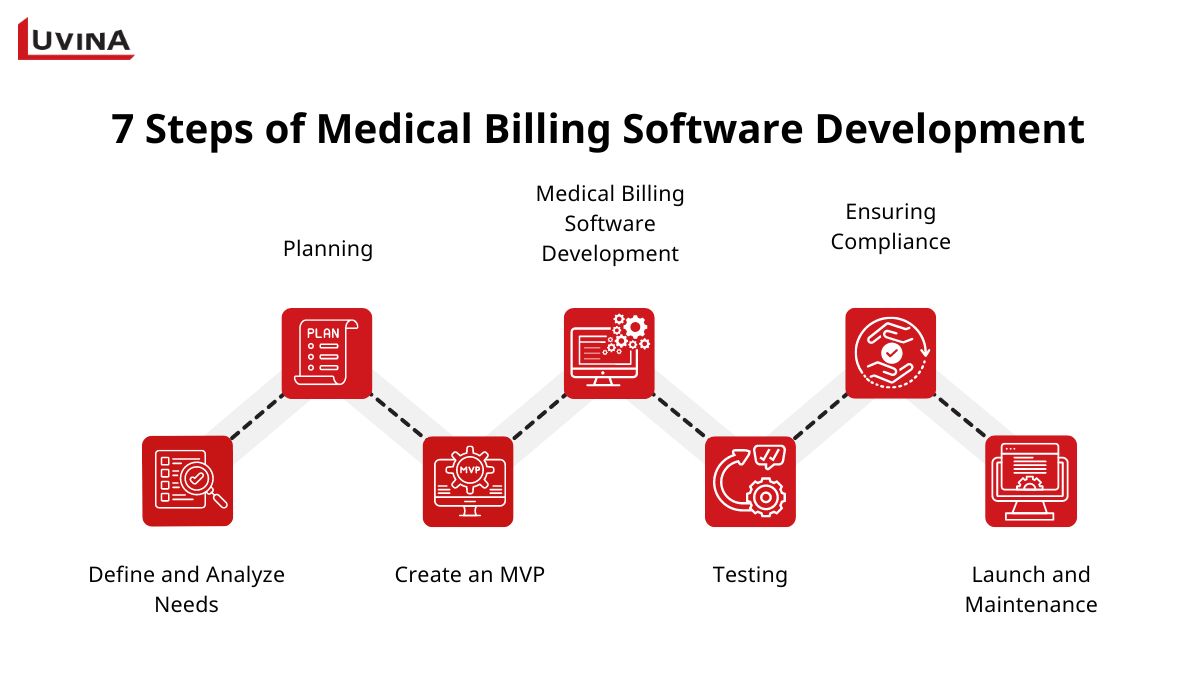
Step 1: Define and Analyze Needs
This is the first step in medical billing software development and serves as a guide for the entire development process. Activities to be conducted in this phase include surveying and interviewing healthcare providers, doctors, nurses, and billing staff on the challenges faced by them in billing processes. For success, the scope of this survey should be wide enough to make sure multiple perspectives are included.
Identifying needs will help you create a software solution that fits the diverse requirements of all parties within a healthcare facility. Prioritize requirements based on their importance and impact on the billing process.
Additionally, during this stage, you should conduct market research. Review the most popular medical billing software, noting their design, and features, and compare them with the needs you’ve identified to plan and develop a feature set that fits your medical billing application.
Step 2: Planning
Planning is crucial for ensuring a smooth medical billing software development process. After understanding user needs and defining core features, create a comprehensive plan. This plan will outline the entire development process, allocate necessary resources, and set timelines for each development phase. Here are some tasks to complete during the planning phase:
- Budget allocation: Distribute funds for different project phases, including costs for hiring personnel, purchasing software licenses, and other necessary resources.
- Assess team skills: Determine if the size and skills of your development team can support bringing the project to realization.
- Finalize features and design ideas: Create a final list of features and design elements you want in the software.
- Choose the platform: Decide whether the software will be a desktop application or available on Android and iOS. Selecting the platform will determine the technology stack you need.
- Select the right technology stack: Choose the technology package based on the project’s requirements and constraints.
Step 3: Create an MVP
Whether you build a solution for a small clinic, a growing business, or a large organization, begin the medical billing software development with an MVP that will include only a minimum of vital functions.
After delivering the MVP to a group of users for testing, actively gather their feedback on the user experience and aesthetics. This stage will help you assess the feasibility of your strategy and make timely adjustments to ensure the final product’s success.
Step 4: Medical Billing Software Development
You are free to develop an in-house development team, outsource it partially for discrete tasks, or even completely by hiring companies that specialize in the development of medical billing software. Implement robust coding for the medical billing software to create a system that accurately processes claims, automates repetitive tasks, and provides a seamless user experience.
Ensure the software integrates smoothly with existing healthcare systems and databases for real-time data exchange, reduced data entry errors, and improved overall efficiency in billing processes.
Step 5: Testing
Testing is an important action in case you do not want your software to crush and disrupt business processes. It will guarantee that your medical billing software will be compatible with other tech solutions you work with. At this stage, quality assurance engineers will perform both manual and automated tests. Such testing will let them find and fix a lot of problems that might include but are not limited to programming errors, performance bottlenecks, and usability problems.
The more testing methods you will try, such as functional, regression, and user acceptance testing, the better you can be assured that the software will work as expected.
Step 6: Ensuring Compliance
Before your medical billing software is launched, it needs to be legally compliant and meet all requirements of privacy and security. You have to:
- – Ensure HIPAA compliance.
- – Fully verify the security attributes of the software: firewalls, intrusion detection, and prevention systems, and regular security check-ups.
- – Strong encryption of sensitive patient data should be established.
- – Establish strict access controls to limit data access to authorized personnel only.
- – Create comprehensive documentation outlining which legal standards your software complies with.
- – Ensuring compliance sets the foundation for a successful software launch.
Step 7: Launch and Maintenance
When the medical billing software has been truly tried out, you are now ready to bring out the software. It is of prime importance that users are trained in how they will be able to work with this software and transition seamlessly from paper billing to digital billing. This would cut down on errors and also prevent unnecessary disruptions. Maintenance is also a critical aspect of medical billing software development. You need to regularly update the software with new security patches, fix bugs, and add new features as needed. Otherwise, your software can quickly become outdated.
Costs of developing medical billing software
Whether you are a small clinic or a large healthcare provider looking to develop a medical billing system, understanding the development costs will help you make informed decisions. According to research, the budget for medical billing software development ranges from $30,000 to $300,000.

The cost varies significantly depending on factors such as the software’s complexity, features, the geographical location of the development team, and the technology stack used. The key cost components in medical billing software development include:
- Development team: Salaries can vary based on the team’s experience and location.
- Features and functionality: The more features and advanced functionalities the software has, the higher the cost, especially for custom features.
- Technology stack: Some technologies may require higher licensing fees or specialized expertise.
- Testing and quality assurance: Automated testing tools and manual testing efforts will incur additional costs, as every software needs thorough testing.
- Compliance and security: Adhering to strict standards and maintaining security measures often demands ongoing maintenance expenses.
- Maintenance and support: Ongoing maintenance, updates, and user support contribute to the overall cost of medical billing software development.
- Project timeline: A rushed project may require additional resources, increasing costs, while longer project timelines can also inflate expenses.
To get an accurate cost estimate, consult software development experts who can assess your specific requirements and provide a suitable estimate based on your project’s scope and specifications.
How can Luvina help?
Medical billing software development is essential for ensuring that your healthcare facility operates smoothly, quickly, and without errors. If you want to take advantage of all the benefits that medical billing software offers, reach out to Luvina. We are proud to support healthcare providers in ensuring information security, optimizing healthcare processes, and developing special care services for special prospects such as the elderly, and pets. With many years of experience in delivering healthcare technology solutions, we focus on the unique needs of hospitals and clinics to find effective solutions for common problems.
Luvina knows exactly how to create reliable medical billing software. We can help businesses build software from scratch or customize and optimize existing systems. With Luvina’s assistance, hospitals and clinics can own high-quality, efficient software, even when dealing with diverse data formats. In addition to medical billing software development, Luvina also offers a range of other healthcare solutions such as:
- EHR/EMR development and integration
- Appointment scheduling application development
- Telemedicine application development
- Building CRM systems for healthcare providers
Looking to partner with experienced developers to optimize your workflows? Contact Luvina today to learn more about the services we offer.
FAQs
What are the different types of billing systems?
There are several types of billing systems in healthcare, including fee-for-service, capitation, and bundled payments. These systems manage tasks such as payment verification, coverage checks, and determining reimbursement structures for medical procedures. Each billing system has its unique features that impact patient payment processes and affect the revenue cycle of healthcare providers.
What tech stack is essential for coding medical billing software?
Medical billing software development often requires the use of various technology stacks to connect the user interface, and administrative interface, and build the database. One crucial component is medical coding software, which plays a vital role in converting medical procedures and diagnoses into standardized codes. Some specialized coding software includes Optum360 EncoderPro.com and 3M CodeFinder Software Suite.
Additionally, here are some other technology stacks you can consider if you’re planning to develop medical billing software:
Backend: Node.js, Nest.js,…
Frontend: JavaScript, HTML5, CSS,…
iOS: Swift, RxSwift, XCTest,…
Android: Kotlin, Coroutines/RxJava, Dagger, Clean Architecture,…
Cloud: AWS Cloud, Google Cloud
Related Posts:









Read More From Us?
Sign up for our newsletter
Read More From Us?
Sign up for our newsletter